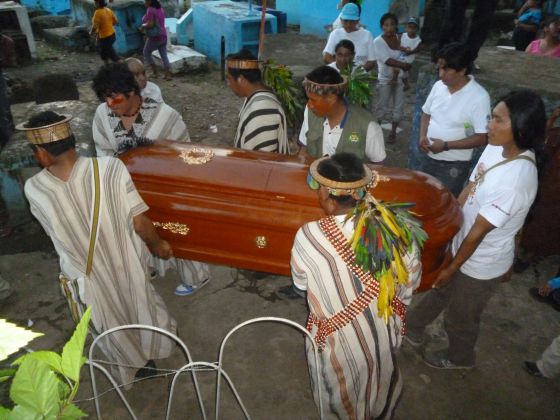Activist's death reveals the vulnerability of local leaders within Peru
JACQUELINE Fowks Lima 8 JUN 2013 - 22:04 TSC1
Filed under: Ecology Deforestation Peru South America Latin America Mining Industry Pollution Environmental Problems Science Environment America

Mauro Pio Peña (57), one of the historical leaders of Ashaninka indigenous people, originating in the central jungle of Peru, was shot dead on Monday May 27 by two gunmen. According to the Regional Association of Indigenous Peoples of the Central Forest (ARPI-SC), those responsible are mafias camouflaged "in the economic and political power" controlling "ground traffic, timber exploitation and resources, and activities associated unlawful. " The murder of the authority of the New Dawn native Hawaiian community has had little impact in the Peruvian capital, as in previous similar cases.
MORE INFORMATION
Chie and Mining in Peru: Growth without Equity
Peña Pio's death reveals the vulnerability that are local leaders in isolated and with little state presence, or because of the complicity of public officials in illegal activities. ARPI-SC The organization has asked the authorities to suspend the activities of the forestry company Balarín, whose concession overlaps the New Dawn Community Hawaii.
The killings at the hands of assassins in Peru occur almost always day, and almost always the gunmen are linear on a motorcycle. So it was with the Ashaninka leader, killed in Satipo, department of Junin. In the statement of the indigenous organization that condemns murder requires "dismissal of the officials of the Government Agricultural Pasco and Junin, for breach of the agreements between the State and indigenous peoples of the central jungle". ARPI has dubbed these violent practices a "new terrorism", because the Ashaninka population was one of the most decimated by the violence of the Shining Path in the eighties and nineties. Now faced another kind of violence that comes along with machinery, money and weapons.
The young Ashaninka leader David Vasquez wrote on his Facebook wall after the death of Mauro Pio: "By tending forests, protect nature and support the peace, let us brother. Goodbye pinkatsari (boss, authority Ashaninka language) ".
On the other hand, in the department of Madre de Dios, the country most affected by illegal alluvial mining in the last 20 years and to a lesser extent by illegal logging, tensions between advocates of water and small farmers with agents of illegal logging are increasing and facing death threats. "We're not environmentalists, here is misunderstood the word, but people who are committed to sustainability and governance with social peace," says El Pais one of those threatened.
In the list of threatened are the biologist César Ascorra, the president of the management committee of the Tambopata National Reserve, Victor Zambrano, the priest Xavier Arbex, of human rights Social Pastoral Vicariate of Puerto Maldonado, Pedro Casanova Association agroforestry producers Mother of God (agroforest); Vidal Salazar, president of the Agrarian Federation of Madre de Dios Department. There have also been attacks on representatives of small formal mining Miguel Herrera Contreras and Armando Carpio Vilma. While leaders of communities of small farmers have been "beaten, threatened with gun and doused with gasoline," adds the source.
Another area affected by illegal mining Casma Province, on the north coast. The progress of this criminal activity has caused three deaths. On December 9, 2012, was killed the mayor of Casma, José Alejandro Montalván Macedo, at the hands of two assassins. In April, another pair of hitmen northern Atlántico Casma provincial prosecutor, Luis Sanchez Colona, who saw murders and illegal mining.
However, in Peru, other defenders of their land who opposed water pollution or unique or fragile ecosystems threatened by formal mining projects, have been killed since 2001. In none of these cases the authorities have determined who were the masterminds although the perpetrators have been temporarily detained. Some of these cases are those of Godofredo Garcia, Remberto Melanio Herrera and Garcia, killed in Piura in 2001, 2004 and 2006 and Edmundo Becerra, veterinarian and member of the Drinking Water Yanacanchilla village of Baja, Cajamarca (northern highlands) , killed in November 2011.

No comments:
Post a Comment